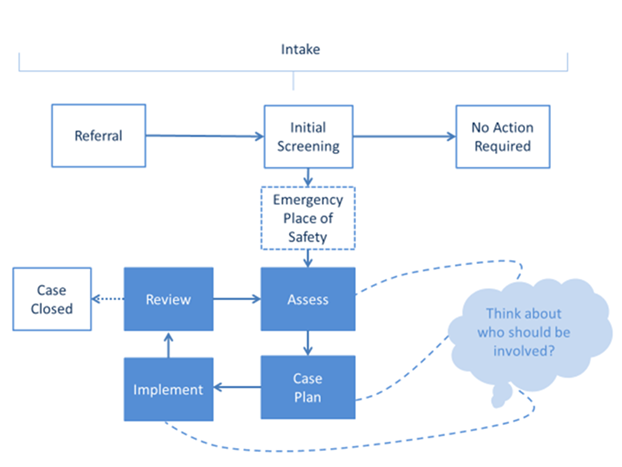2 / 5 —Registration/ Intake
Case Intake is when a child’s needs correspond to a given criteria during assessment stage
- Registration involves —
- Giving information and seeking informed consent
- Taking standard registration information
- An initial assessment should be conducted
4 / 5 —Assessment
4 / 5 —Case Plan
Case PLan is based on the assessment
- Involves the child and family and should address the needs identified in the assessment and a good plan considers
- Vulnerabilities, risks and harm factors and
- Protective influences, strengths and resilience of child and family
- What should happen (to meet identified immediate, short, medium and long-term needs)
- Who should do it?
- When they should be done? Timelines
5 / 5 —Implementing the Case Plan
All services should be provided in terms of a plan which means (what, who, when?)
- Work with child, family and other actors (as needed/consented ) to take action to realise the case plan
- Direct support and services: Provided by the caseworker (e.g. information, advice) and services directly obtained
- Referrals to other agencies or service providers where necessary
4 / 5 —Follow-Up and Review
Follow-Up: Checking a child and family’s needs are being met throughout the case management process. This could be done through home visits
- Review: Reflecting on the case plan’s implementation
- Are objectives being met?
- Does the case plan remain relevant?
- If not, how to adjust the case to make it responsive?
4 / 5 —Case Closure
Or Case Resolution
- The point at which work with the child ends – end of the Plan as well
- Criteria for case closure should be set by the Department
- Case work process is a contract and any contract comes to an end at some point but that end should clear to both parties
- Case closure should be authorised by a manager/supervisor from the department of social welfare
5 / 5 —Points to Note About Closure
Case closure requires certain processes to be followed including communicating the step to the child and family and evaluating the whole intervention.
Case closure is the last of the case management steps but an incredibly important one
- If we do not close cases we are not able to:
- Keep track of our work
- Start new cases
- Give children and families a sense that they have achieved their case plans
